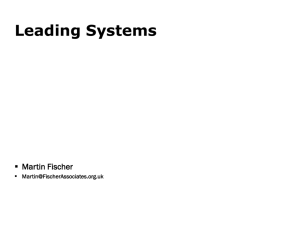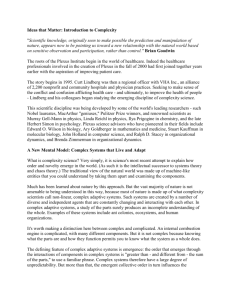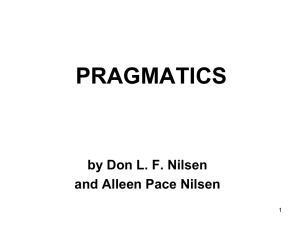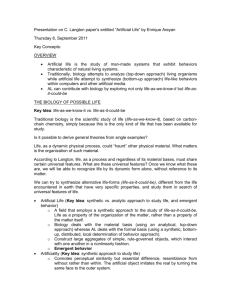CSE633 Boids Flocking Simulation: by Shaun Cosgrove
advertisement
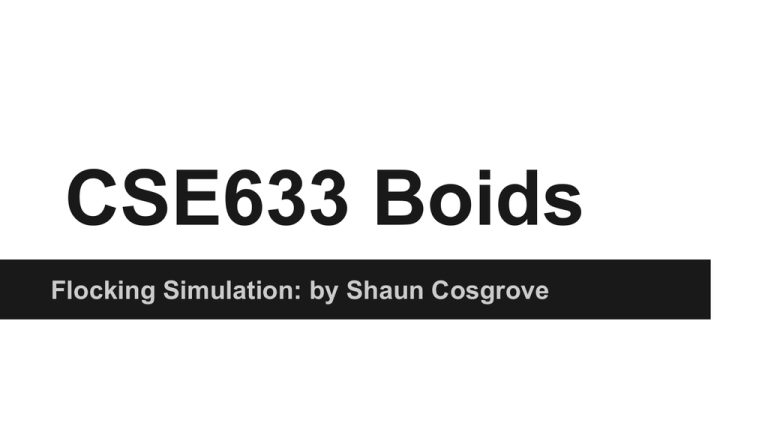
CSE633 Boids Flocking Simulation: by Shaun Cosgrove Boids “Boids” is the phonetic spelling of “Birds” when spoken with a New York accent Flocking Simulation ● Originally simulator for the flocking behaviour of birds ● Simple set of rules ○ Emergent Behaviour ■ Complexity arises from the interaction of individual Boids Boids Rules ● Separation ● Alignment ● Cohesion Images Credit http://www.red3d.com/cwr/boids/ Implementation Example Processor 1 Processor 2 Processor 3 Processor 4 …. …. …. CSE633 Boids Implementation & Analysis Flocking Simulation: by Shaun Cosgrove Boids Rules ● Separation ● Alignment ● Cohesion Images Credit http://www.red3d.com/cwr/boids/ Static Spatial Decomposition 1 2 Divide total area into sub areas ● Assign each sub area to a processor 3 4 5 6 7 8 9 ~4000m ● ~4000m ● Perform computation on each sub area ● Sync data ● Repeat Shared Borders 1 4 7 2 5 8 ● Computation on any sub areas requires data from every neighbour ● Transmit all boids to / from neighbours? ● Necessary to reduce communication requirements for faster implementation 3 6 9 Sub Area Optimizations 1 2 3 4 5 6 7 8 9 5,1 5,2 5,3 5,4 5,5 5,6 5,7 5,8 5,9 ● Binning of Boids ● Each sub area divided into bins ● Boid algorithm performed on binned Boids Border Communication 1 2 ● Boids sphere of influence goes outside local sub area ● Correct Simulation Requires Data from each neighbour ● Make each computation communicate with neighbours for data? ● How much data to get? ● Efficiency very important 3 4 5 6 7 8 9 Communication Optimization 1 2 3 4 5 6 7 8 9 4 2 5,1 5,2 5,3 5,4 5,5 5,6 5,7 5,8 5,9 8 6 ● Take the border bins ● TX and RX all boids in these bins to their respective neighbours ● Buffer neighbour Boids for processing in all sub-areas ● Ensures correct simulation in all sub areas Communication States Barrier Boid Lengths Boid Lists Application Sequence Processing Comm Barrier Processing Comm Barrier Processing Comm Barrier Processing Comm Barrier Notes ● Running time of algorithm is heavily dependent on Boids configuration ● Tighter flocking results in slower running times ● This implementation: ○ Un-optimized ○ Heavily dependent on arraylists ○ Has a large memory overhead Test Setup ● ● ● ● ● ● Fixed area ~4000 x ~4000 m Fixed bin dimension of 40 x 40 m Variable bin size per test size Scalable implementation 900 - 230,400 Boids 3x3 - 10x10 sub areas Brute Force Vs Optimized Algorithms Optimized Algorithm Single Instance Optimized Algorithm - Parallel Instance Times Speed Up vs Single Instance Theoretical Growth Rate Boids Comp: Brute Comp: Grid 900 810000 8100 As each Boid must be checked against every other Boid to determine if it is in its sphere of influence, this is a O (n2) algorithm 1800 3240000 16200 Grid based: Assuming even Boid distribution 3600 12960000 32400 7200 51840000 64800 14400 207360000 129600 28800 829440000 259200 The table above shows the number of comparisons required to perform the algorithm for one cycle for an increasing number of boids Brute force: (Nested for loop) Each Grid has a size that is no less than the sphere of influence of the individual Boids. To correctly perform the simulation for Boid_A, only the Boids in the 8 neighbouring Grids and the Boids in the current Grid need to be checked. As these will be the only Boids that can be in the sphere of influence of Boid_A the simulation will be accurate. With even Boid distribution, this is a O(a*n) algorithm for some constant a Actual Growth Rate* ● Growth of the optimized version increases towards O(n2) with large numbers of boids but its running time is orders of magnitude faster than the Brute Force algorithm *Running times for brute force are projected above 14400 Boids. The actual growth rate is expected to be at least this amount Actual Growth Rate 16 proc ● The growth of the optimized algorithm moves towards O(n2 ) after a certain number of boids is reached. ● Note: The tests run with smaller number of Boids will show greater jitter due to the small scale of the simulation, the mpi implementation and certain other random factors inherent to the simulation Actual Growth Rate 81 proc ● ● Again, the growth of the optimized algorithm moves towards O(n2 ) after a certain number of boids is reached. This is true for no matter the number of processors that are used in the test Actual Growth Rate Actual Growth Rate ● ● ● ● As the number of Boids increases, the growth rate of the optimized algorithm nears or exceeds O(n2) This will be in part due to uneven distribution of the Boids during the simulation for the optimized algorithm. The Boids will naturally flock together in certain regions meaning that for a Boid in a dense region, many more comparisons will be required to correctly execute the simulation. As more Boids are added to the same space, the Boids will be more compact compounding the natural grouping nature of the Boids and the growth of the optimized algorithm increases For simulations with larger numbers of Boids, even though the growth rate is similar to the brute force algorithm, the actual running time per instance is orders of magnitude faster as can be seen in the first graph above References ● ● ● ● Arup Guha for sample implementation of arraylist Michael Clark <michael@metaparadigm.com> for json-arraylist implementation Flocking by Daniel Shiffman - Processing Implementation ○ Processing 2.1.1 Example Craig Renolds: Original algorithm designer
